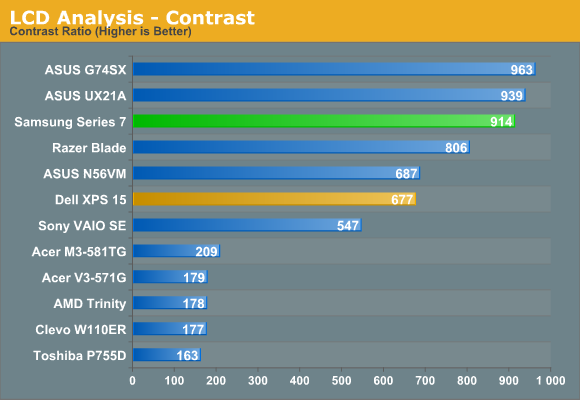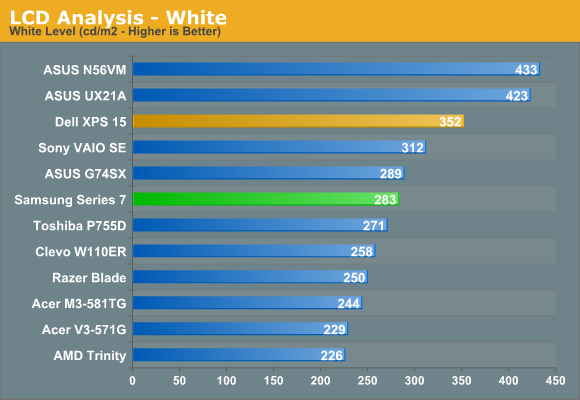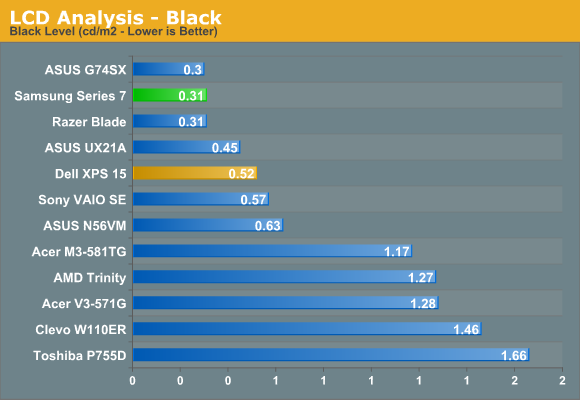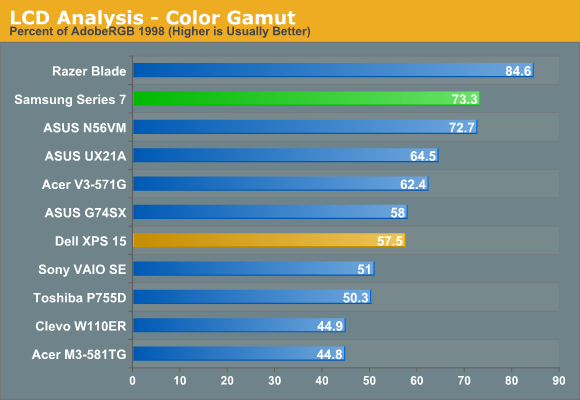Samsung Series 7 NP700Z7C Review
by Jarred Walton on August 16, 2012 2:05 AM ESTSamsung Series 7 LCD: About As Good As TN Gets
Apple, ASUS, HP, Lenovo, and Sony have made some waves over the past year by equipping certain laptop models with IPS displays. In the case of Apple, they’re shipping the highest resolution display ever seen in a consumer notebook. ASUS hasn’t gone quite as far as Apple, but they still have a couple of the highest DPI displays we’ve ever seen with 1080p panels in the 11.6” UX21A and the 13.3” UX31A. We’d love to see more manufacturers jump on the high quality IPS display bandwagon; Samsung isn’t there with the Series 7, but they do get a couple things right: first, they use a high contrast display, and second they use a matte LCD. Here’s how it stacks up to the competition.





Contrast is very good at 914:1, and when you factor in the other laptops using glossy displays it’s even better—matte LCDs usually give up about 10% of their contrast. The maximum white level is a bit lower than we’d like, registering 283 nits, but again the matte surface will help if you use the notebook in brightly lit environments. Perhaps equally important is that the colors are very good—only the IPS displays in the ASUS UX21A and the Sony VAIO SE deliver lower Delta E results, and if you work in the sRGB color space the Series 7 is just about perfect. I still prefer IPS displays like that in the VAIO SE personally, even if the color space isn’t quite as good, but opinions on that differ.
Of course the biggest problem with TN panels (besides using 6-bits and dithering instead of true 8-bit color) is that vertical viewing angles aren’t very good. The Series 7 appears to use a Chi Mei/Innolux N173HGE-L11, and its viewing angles are much better than low-end TN panels, but if you happen to be sitting in coach on a flight trying to get work done (like I was at one point during this review), it’s still going to present some problems. Then again, I’m not sure how many people would actually try using a 17.3” notebook on a plane.


_thumb.jpg)
_thumb.jpg)
_thumb.jpg)
_thumb.jpg)
_thumb.jpg)
_thumb.jpg)








50 Comments
View All Comments
mbishof - Thursday, August 16, 2012 - link
I know it's probably not as sleek or thin, but then neither is the ASUS N56VZ that you suggested for the "technology addict" or "gamer." I want a laptop that acts as mobile workstation by day and gaming laptop by night. What do you think of the lenovo Y580? Right now they have a model with a 1080p screen for under $1k . Pop in a 128GB msata SSD for an additional $150 or so and it seems like that's quite a compelling choice. I'd love to see an in depth review of that machine.JarredWalton - Thursday, August 16, 2012 - link
Honestly, it's extremely similar to the ASUS N56VZ but with a couple minor differences. First is that the ASUS appears to get slightly better battery life, which is related to the second aspect: the Y580 comes with a GTX 660M GPU. It's only a slight clock speed increase from the GT 650M, and I'm not sure I'd call the 660M worthy of the GTX branding, but it's still faster.The keyboard on the Y580 looks nearly identical to the ASUS layout, they both come with Blu-ray, and most of the specs are about the same elsewhere. It's really just a preference for the LCD (ASUS has a matte 1080p display whereas the Lenovo is glossy), plus the ASUS is cheaper, and lastly ASUS isn't afraid to send us review units so I've actually had hands-on time with the N56VZ. I should also mention that Lenovo uses a 5400RPM HDD with a 32GB SSD cache, where ASUS uses a 7200RPM HDD with no cache. If you're going to replace the HDD with an SSD, there's not much point in having the 32GB mSATA SSD hanging around IMO (or as you note, you could look for an mSATA SSD).
mbishof - Thursday, August 16, 2012 - link
Unfortunately my retailers of choice do not offer a N56VZ in the US with a 7200RPM hard drive. Also, the N56VZ uses a GT650 with DDR3 memory which a trustworthy site has informed me will not perform as well as the DDR5 version (although they did point out the boost in clock frequency will compensate the slower memory somewhat). Lenovo does offer a variant of the Y580 with a 500GB 7200RPM drive and no mSATA SSD so my plan is to just do a fresh install on a 128GB mSATA that I pick up from crucial. Sounds like a driver installation nightmare waiting to happen but who knows, it could work.sigmatau - Thursday, August 16, 2012 - link
I'm not sure I'd buy a Lenovo after I found a survey they did about matte vs glossy displays.... 6 years ago. I guess it didn't matter that 86% of the participants voted for matte and spitted on glossy. They removed the survey from their forums... probably from shame.I mean who cares what the customer wants.
http://arstechnica.com/gadgets/2006/10/8022/
JarredWalton - Friday, August 17, 2012 - link
One problem with that Ars article is this line: "There are some advantages to having a glossy screen: in particular, outdoor visibility is greatly increased." WTF? Outdoor visibility is increased by glossy? Where are they using such screens "outdoors"? Because all I get on glossy screens outside is a nice reflection of my face. :-\Dribble - Thursday, August 16, 2012 - link
It should never throttle on a brand new laptop - if it gets that hot then the cooling is insufficient. This means inconsistent performance, noisy cooling as the fan is maxed out, and the cpu/gpu dying young due to being run so hot all the time.Remember that laptop is new, the fan is clean, it's as good as it will get. Use it for a few months and the cooling system will have dust in it and be significantly less efficient - the laptop will be continuously throttling. Sure you can clean it out, but most people don't want to have to clean out the fans every month to keep their machine usable.
JarredWalton - Thursday, August 16, 2012 - link
I'm not sure how you consider about three pages worth of discussion on throttling and a conclusion that says "gamers and enthusiasts should probably look elsewhere because of the throttling issues" as being accepting. There are many people who would only occasionally game, and if you want a nice looking notebook with a good display and keyboard there aren't that many options. Certainly the Series 7 looks nicer than the ASUS and Lenovo laptops mentioned elsewhere, with a better keyboard layout as well. For everyday use, I'd take the Samsung over the other two, but I'd do it knowing that gaming/graphics are going to have thermal issues at times. That means you're spending about $250 on hardware you won't use much, but people have done worse things.bennyg - Saturday, August 18, 2012 - link
I would think the issue is more longevity rather than performance.Remember, most people don't even think to blow out fans/grilles with air, let alone pull the thing apart and clean it properly. Add dust to something that can't cool itself properly to start with = problems.
Or am I just old-fashioned in wondering what the product's use will be like in 1 or 2 years' time. All I'm supposed to consider is looks and price and maybe a few spec tags like "i7" and "8gb ram". Ugh I hate 'consumers'.
MadMan007 - Thursday, August 16, 2012 - link
The temperature graphs have MHz for the vertical axis instead of degrees.JarredWalton - Thursday, August 16, 2012 - link
Ugh... I hate it when I do things like that. These are all manually created charts as well (for the clocks/temps), so I have to go into Excel, edit the chart, then take a screen capture, paste into Photoshop, crop, save, and upload the result to our CMS engine. What a pain! Anyway, the charts are all fixed now (I hope!)